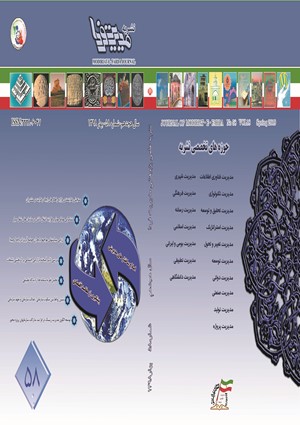Development of Multivariate Regression Relationship Between Factors Affecting Unemployment Rate
Subject Areas :roya soltani 1 , mahnaz ebrahimi sadrabadi 2 , Ali Mohammad Kimiagari 3
1 -
2 -
3 -
Keywords: unemployment rate, multi-variable linear regression, economic participation rate inflation rate,
Abstract :
In this research, the multi-variable linear regression relationship has been developed among the important factors influencing unemployment rate. The seasonal data is from 1394 to 1394, which is compiled from reliable economic data bases of country. Independent variables are: net foreign assets of the banking system (billion rials), net debt of the public sector to the banking system (billion rials), liquidity in terms of its constituent parts (billion rials), rate of dollar (rials), economic participation rate, average inflation rate, The average annual interest rate on state-owned banks, the percentage of jobseekers (65-15). The results indicate that there is a negative and significant relationship between unemployment rate and average inflation rate and economic participation rate, while the net debt of the public sector has had a positive and significant relationship with the banking system and unemployment rate. The greatest negative effects on unemployment rate are the rate of economic participation and the greatest positive impact on the unemployment rate is the net debt of the public sector to the banking system.
مرکز آمار ایران.
امور اقتصاد کلان سازمان برنامه و بودجه کشور.
بانک مرکزی جمهوری اسلامی ایران.
دفتر مدل سازی و مدیریت اطلاعات اقتصادی - معاونت امور اقتصادی - وزارت امور اقتصادی و دارایی.
قاسمی، فاطمه (1389)، بررسی و تحلیل عوامل موثر بر اشتغال در ایران: رویکرد بین بخشی، پایاننامه کارشناسی ارشد.
صنعت خواه، علی رضا (1388)، بررسی عوامل مؤثر بر بیکاری فارغ التحصیلان دانشگاه ها، ماهنامه اجتماعی- اقتصادی- علمی- فرهنگی،(109): 58-75.
فیض پور، محمد علی (1389)، دوره بيكاري و عوامل موثر بر آن شواهدي از بيكاران جوياي كار استان يزد طي برنامه سوم توسعه، فصل نامه علمی-پژوهشی رفاه اجتماعي(39):327 -356 .
امینی، علیرضا ، منصوری، فرزانه (1387)، تحلیل عوامل موثر بر اشتغال جوانان به تفکیک بخشهای عمده اقتصادی ایران، پژوهشنامه اقتصادی (3): 121-139.
پاسبانی، ابوالفضل، شعلی بر، شیما و مودی، مرضیه(۱۳۹۲)، بررسی وضعیت بیکاری و اشتغال در چند سال اخیر: عوامل موثر بر اشتغال زایی، اولین کنفرانس بین المللی حماسه سیاسی (با رویکردی بر تحولات خاورمیانه) و حماسه اقتصادی (با رویکردی بر مدیریت و حسابداری)، رودهن، دانشگاه آزاد اسلامی واحد رودهن.
ضیابخش، نگار، کیمیاگری، علیمحمد و محمودیآذر(1395)، کیوان، ارائه روش علمی برای تخمین تابع هدف میزان سرمایه در گردش شرکتهای صنعتی؛ مورد مطالعاتی ایرانخودرو و سایپا از شرکتهای خودرویی بورس اوراق بهادار تهران، سومین همایش ملی و سومین همایش بین المللی مدیریت و حسابداری ایران.
Kong, J. (2011), Factors Affecting Employment, Unemployment, and Graduate Study for University Graduates in Beijing. In: Zhou Q. (eds) Advances in Applied Economics, Business and Development. ISAEBD. Communications in Computer and Information Science, Vol. 209, Springer, Berlin, Heidelberg.
Frumkin, N. (1998), Tracking America’s economy. New York: M.E. Sharpe.
Collins, R. (2009), Factors related to the unemployment rate: A statistical analysis, Honors Program Theses. 9.
Aurangzeb, D., and Asif, K. (2013), Factors Effecting Unemployment: A Cross Country Analysis, International Journal of Academic Research in Business and Social Sciences, Vol. 3, No. 1.
Tunah, H. (2010), The Analysis of Unemployment in Turkey: Some Empirical Evidence Using Co-integration Test, European Journal of Social Sciences, Vol. 18, No. 1: 18-38.
Lui, L. Q. (2009), Inflation and Unemployment: The roles of goods and labor market institution, job market paper.
Pallis, D. (2006), The tradeoff between inflation and unemployment in new European Union Member-states, International Research Journal of Finance and Economics, No. 1: 81-97.
Cashell, W. B. (2004), Inflation and unemployment: What is the connection, Federal Publications?
Amini A. (2002), Analyzing Effective Factors on Economic Sectors’ Labor Demand and Employment Projections in the 3rd Development Plan. The Journal of Planning and Budgeting. Vol. 7, No. 2: 53-86.


